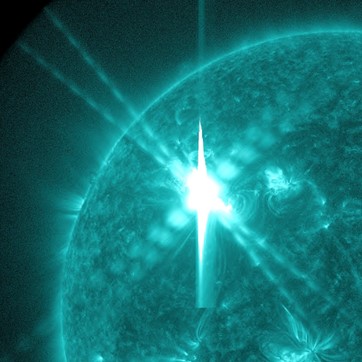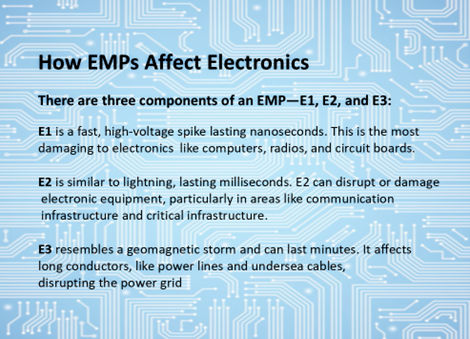When someone mentions electromagnetic pulses (EMPs), we conjure visions of nukes, terrorists, Starfish Prime, and Armageddon. Would your ham radio be in danger? Statistically, your radio is more likely to be damaged by lightning, power surges, high SWR, and dumb mistakes. Think about the last time you let the smoke out of your radio or fried your finals.
Though they happen infrequently, electromagnetic pulses are a real and potentially devastating threat to modern technology, including ham radios. While ham radios have often been recognized for their reliability in emergencies, EMP poses some challenges.
The Reality of EMP
The severity of the threat depends on the type of EMP and the precautions you take to protect the equipment. An EMP is a powerful and short-lived radio signal with enormous bandwidth. It can originate from several sources, some of which are more hazardous and destructive than others.
Here’s a breakdown of the types of EMP, listed in order of most likely to occur:
- Solar EMP (Coronal Mass Ejections—CME): Caused by solar flares, these events can also generate powerful electromagnetic pulses. We’ve recently had our share of these. On May 10, 2024, the first G5, or “severe,” geomagnetic storm in over two decades hit Earth. CMEs are also making appearances in 2025. Some coronal mass ejections are relatively mild, but then there are others like the Carrington Event of 1859. The most intense CME in recorded history, the Carrington Event caused telegraph systems all over Europe and North America to fail. It created strong auroral displays that were reported globally and caused sparking and even fires in telegraph stations.

- Conventional E-Bombs: E-bombs, or electromagnetic bombs, are specialized non-nuclear weapons designed to disrupt or destroy electronic systems and information networks. They work by generating a powerful EMP that can damage or incapacitate sensitive equipment, effectively “killing” the electrical systems of a target area.
- Nuclear EMP (NEMP): This type of EMP is generated by a nuclear explosion, particularly high-altitude detonations. High-altitude EMPs (HEMP) occur when a nuclear explosion happens at an altitude above 30 miles, generating a powerful EMP over a large geographic area. This is considered the greatest threat to amateur radio equipment, the grid, and electronics in general. If a detonation is close enough to cause any damage, saving your gear will probably be the least of your worries.
Source-Region Electromagnetic Pulse (SREMP) is generated by low-altitude nuclear detonations (below 5km). While it affects a smaller area, it can be devastating to electronics within that zone.
An EMP burst itself is harmless to humans and pets—it’s like being exposed to a very bright light for a very short time. A pulse can emit damaging radiation, but the health risk associated with this brief exposure is negligible.
A solar-made EMP is much more likely, but the effect of even a large solar-made EMP is so minimal that we earthlings will barely notice it, unless we consult the N0NBH Solar-Terrestrial Data chart. Even if the predicted event will be large enough to notice, chances are you’ll have a day or two to prepare for it. And to prepare for it, stow your ham radio equipment in your car (assuming your car has a steel body), wrap in layers of foil or utilize a Faraday cage, and disconnect your radios from outdoor antennas. For the rest of your appliances, unplug them from the wall.
Depending on the strength of the EMP and how exposed your equipment is, your ham radio equipment might not be affected at all or it can get burned to a crisp. The only two types of significant EMP your equipment will likely be exposed to are those made by nuclear and solar sources.

EMP Effects on Radios
EMPs can induce high voltages and currents in wiring and circuitry, potentially damaging or destroying components such as transistors, microprocessors, and sensitive front-end circuitry. The HF bands utilized by many ham radio operators are more susceptible to EMP damage because they fall within the frequency range where EMP energy is concentrated.
There’s a common belief that older analog radios are immune to EMP, but this isn’t entirely accurate. Vacuum tube equipment and older, simpler designs are generally more robust than modern solid-state devices. Still, they are not immune if directly connected to power lines or antennas during an EMP event. I’ll have to admit that I still keep my old Heathkit HW-101 and power supply in storage, testing it once or twice a year—just in case.
On the other hand, handheld radios (HTs), especially those not connected to external antennas or powered on, stand a better chance of surviving. These devices, stored in protective metal enclosures, are even more likely to withstand an EMP strike.
An EMP originating from a large enough solar flare can destroy, if not temporarily disable, ham radios or other electronic devices such as cell phones, computers, televisions, and home control devices. This is because, like a radio antenna, each device can absorb a bit of that high-energy pulse. Using the same radio antenna analogy, the smaller the device, the less it can absorb the pulse. Fortunately, most of these electronic devices can be easily protected from a typical solar EMP event.

Protective Measures
Containers that provide effective EMP shielding against an average-sized solar attack include your car, refrigerator, aircraft, a shipping container, and your house—if it’s covered with aluminum siding. Some household metal containers—such as paint cans, metal garbage cans, metal ammo cans, and cookie tins—can also serve as effective shields. If you want to use a more extreme solution, enclose the equipment inside a Faraday cage.
Other suggestions include:
- Disconnect equipment: The most basic measure is to disconnect radios from power outlets and antennas when not in use. It makes good sense to disconnect them, something many of us do when there’s a thunderstorm.
- Surge protectors: Installing surge protectors or transient voltage suppressors on power lines and antenna connections can help divert EMP-induced surges.
- Grounding: Properly grounding your radio equipment and antenna system can help dissipate EMP-induced charges.

